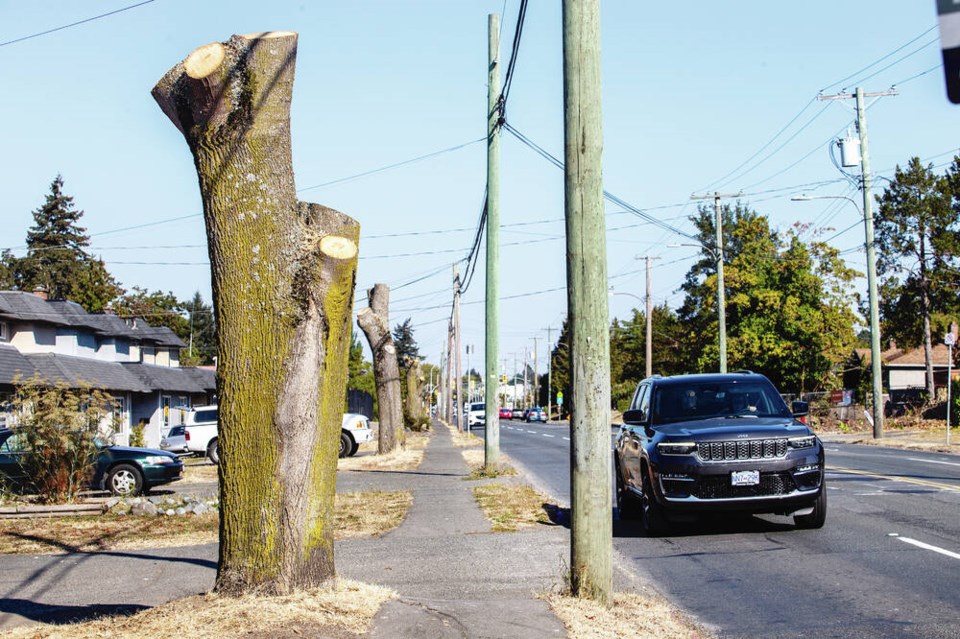The sound of chainsaws mixed with the noise of heavy traffic along Shelbourne Street on Monday as crews continued cutting down trees along the busy corridor.
Pedestrians stopped to watch and rubber-necking drivers strained to see as giant pieces of a London plane tree and chunks of cypress were be hoisted onto a flat deck truck.
Shade that normally spreads across yards and into the street was suddenly gone.
“I’ll miss it, but we expected it … and I know life has to move forward,” said long-time homeowner Lynda Rosemus.
“I’m used to looking out and seeing the leaves and some shade, but I think it will make Shelbourne a safer place.”
Dozens of trees between North Dairy Road and Pear Street are coming down as Saanich starts the second phase of its Shelbourne Street Improvement Project.
The downed trees are making way for northbound and southbound protected bike lanes, replacement of water, sewer and storm drains and the removal of power poles for underground utilities, plus pullout bus stops, new lighted pedestrian crossings and sidewalks.
Saanich is taking about a metre on both sides for the changes. Shelbourne will remain two lanes both ways for motor traffic.
It can’t come fast enough for Sandy McArthur, who was having difficulty navigating a narrow sidewalk near Knight Street.
“It’s dangerous,” he said as he made his way to Hillside shopping centre Monday afternoon. “It’s good they’re doing this.”
Wayne Stuart, who has rented a house on Shelbourne near Browning Park for the past decade, has one giant London plane tree scheduled for removal and a cedar hedge destined for the chainsaw outside his home. He wasn’t happy about losing shade and a buffer from the traffic.
“I’m also going to lose my driveway,” he said, noting the road changes will cut into the property by about a metre. “I’m not a fan of this happening, but what can you do?
“I’m paying $1,500 a month here and I know I’d never get that if I moved right now,” said Stuart. “I guess I just have to live with it.”
Saanich said it has spent the past two years consulting with residents regarding the scope and specifics of the Shelbourne Street project, including the trees that are being removed.
Harley Machielse, director of engineering, said the district is aware that there are community concerns about the removal of trees.
He said the project plan ensures that the number of trees that need to be removed is as few as possible and, for every tree that is removed, three will be planted within the project area or elsewhere in Saanich (about 350 in total), citing the municipality’s Tree Protection Bylaw.
Saanich said in a statement on Monday it acknowledges that some of the mature trees hold a historical significance but none of the trees removed were from the original Memorial Avenue plantings in 1921.
That year, 600 London plane trees were planted from PKOLS Mount Douglas in Saanich to Bay Street in Victoria in honour of the 600 British Columbia soldiers lost in the Boer War and First World War.
Geoffrey Bird, a professor at Royal Roads University who recently produced a short documentary on the significance of memorial plantings — partially funded by Saanich, said only about 200 of the trees remain due to development and road building over the years. He said there are about 100 in each of Victoria and Saanich.
Bird said it’s difficult to determine which of the London plane trees were part of the official plantings or were part of volunteer plantings that took place around the same time or in later years.
“They are big, beautiful trees that require a lot of earth and space, and understandably there is a sense of shock when some of these trees come down,” said Bird.
The memorial has been expanded to represent soldiers from all of Canada’s conflicts, with new trees planted as recently as 2010 to honour fallen soldiers in Afghanistan.
“Many of these trees live on and continue a remembrance for the community,” said Bird.
The second phase of the Shelbourne Street Improvement Project will also see the installation of the University of Victoria bike connector: an upgraded cycling route between Shelbourne and UVic with cycle lanes along Pear Street and Poplar Avenue and a raised multi-use path from Poplar Avenue to Richmond Road.
The work, spanning Shelbourne Street from North Dairy Road to Torquay Drive, is expected to take about 24 months and cost $23 million.
The first phase, completed in July, saw the installation of north and southbound buffered bike lanes north of McKenzie Avenue to Torquay Drive.
Phase three will address the street from Pear Street to Garnet Road.
> Online: warheritage.royalroads.ca/trees-of-remembrance
>>> To comment on this article, write a letter to the editor: [email protected]



